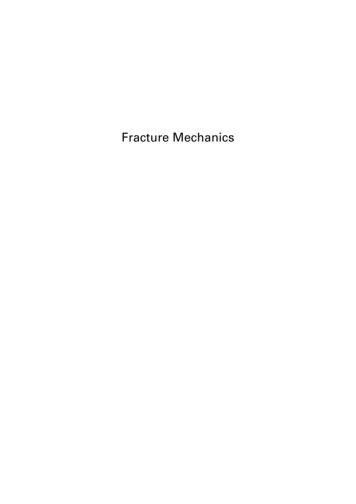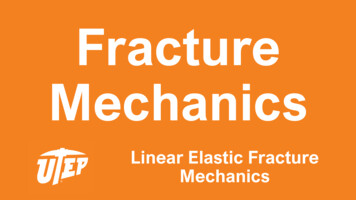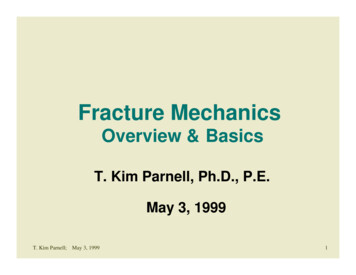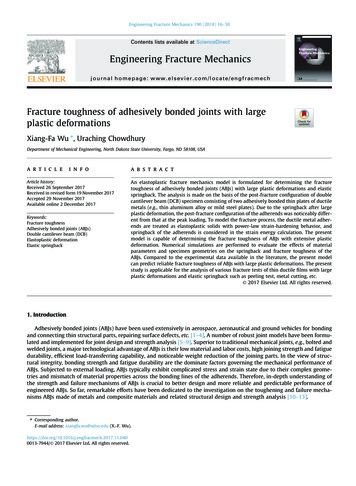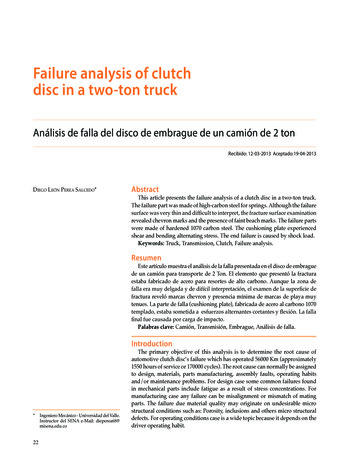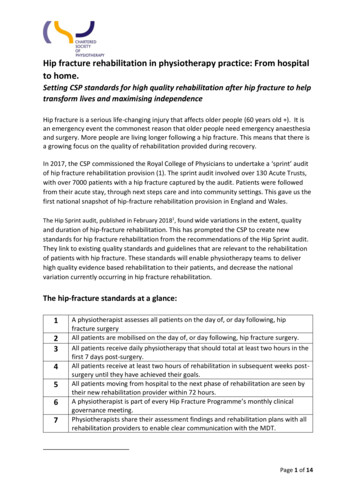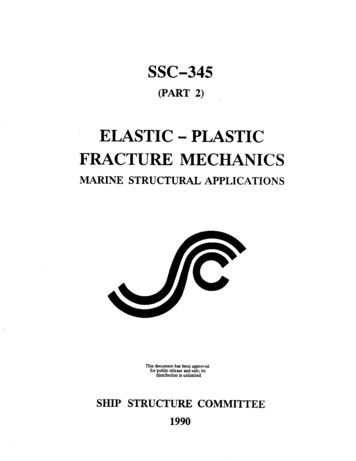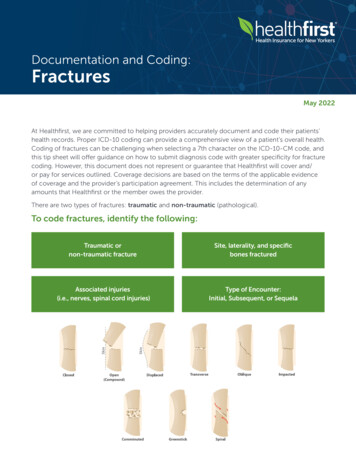
Transcription
Modeling Fracture and Failure with Abaqus2017
About this CourseCourse objectivesUpon completion of this course you will be able to:Use proper modeling techniques for capturing crack-tip singularities in fracture mechanics problemsUse Abaqus/CAE to create meshes appropriate for fracture studiesCalculate stress intensity factors and contour integrals around a crack tipSimulate material damage and failureSimulate crack growth using cohesive behavior, VCCT, and XFEMSimulate low-cycle fatigue crack growthTargeted audienceSimulation AnalystsPrerequisitesThis course is recommended for engineers with experience using Abaqus3 days
Day 1Lecture 1Basic Concepts of Fracture MechanicsLecture 2Modeling CracksLecture 3Fracture AnalysisWorkshop 1Crack in a Three-point Bend SpecimenWorkshop 2Crack in a Helicopter Airframe Component
Day 2Lecture 4Material Failure and WearLecture 5Element-based Cohesive BehaviorWorkshop 3Crack Growth in a Three-point Bend Specimen using Cohesive Connections (Part 1)Workshop 4Crack Growth in a Helicopter Airframe Component using Cohesive ElementsLecture 6Workshop 3Surface-based Cohesive BehaviorCrack Growth in a Three-point Bend Specimen using Cohesive Connections (Part 2)
Day 3Lecture 7Workshop 5Virtual Crack Closure Technology (VCCT)Crack Growth in a Three-point Bend Specimen using VCCTLecture 8Low-cycle FatigueLecture 9Mesh-independent Fracture Modeling (XFEM)Workshop 6Crack Growth in a Three-point Bend Specimen using XFEMWorkshop 7Modeling Crack Propagation in a Pressure Vessel with Abaqus using XFEM
SIMULIASIMULIA is the Dassault Systèmes brand for Realistic Simulation solutionsPortfolio of established, best-in-class productsAbaqus, Isight, Tosca, fe-safe, Simpack* Included in extended licensing pool
SIMULIA’s Power of the PortfolioAbaqus Routine and Advanced SimulationLinear and Nonlinear, Static and DynamicThermal, Electrical, AcousticsExtended Physics through Co-simulationModel Preparation and VisualizationIsight Process IntegrationDesign OptimizationParametric OptimizationSix Sigma and Design of ExperimentsTosca Non-Parametric Optimization Structural and Fluid Flow Optimization Topology, Sizing, Shape, Bead Optimizationfe-safe Durability Simulation Low Cycle and High Cycle Fatigue Weld, High Temperature, Non-metallicsSimpack 3D Multibody Dynamics Simulation Mechanical or Mechatronic Systems Detailed Transient Simulation (Offlineand Realtime)Realistic Human SimulationHigh Speed Crash & ImpactNoise & VibrationMaterial CalibrationWorkflow AutomationDesign ExplorationConceptual/Detailed DesignWeight, Stiffness, StressPressure Loss ReductionSafety FactorsCreep-Fatigue InteractionWeld FatigueComplete System Analyses(Quasi-)Static, Dynamics, NVHFlex Bodies, AdvancedContact
Join the Community!How can you maximize the robust technology of the SIMULIA Portfolio ?Go to www.3ds.com/slcto log in or join!
SIMULIA ia/services/training-courses/
Legal NoticesThe software described in this documentation is available only under license from Dassault Systèmesor its subsidiaries and may be used or reproduced only in accordance with the terms of such license.This documentation and the software described in this documentation are subject to change withoutprior notice.Dassault Systèmes and its subsidiaries shall not be responsible for the consequences of any errors oromissions that may appear in this documentation.No part of this documentation may be reproduced or distributed in any form without prior writtenpermission of Dassault Systèmes or its subsidiaries. Dassault Systèmes, 2016Printed in the United States of America.Abaqus, the 3DS logo, and SIMULIA are trademarks or registered trademarks of Dassault Systèmes orits subsidiaries in the US and/or other countries.Other company, product, and service names may be trademarks or service marks of their respectiveowners. For additional information concerning trademarks, copyrights, and licenses, see the LegalNotices in the SIMULIA User Assistance.
Revision StatusLecture 111/16Updated for Abaqus 2017Lecture 211/16Updated for Abaqus 2017Lecture 311/16Updated for Abaqus 2017Lecture 411/16Updated for Abaqus 2017Lecture 511/16Updated for Abaqus 2017Lecture 611/16Updated for Abaqus 2017Lecture 711/16Updated for Abaqus 2017Lecture 811/16Updated for Abaqus 2017Lecture 911/16Updated for Abaqus 2017Workshop 111/16Updated for Abaqus 2017Workshop 211/16Updated for Abaqus 2017Workshop 311/16Updated for Abaqus 2017Workshop 411/16Updated for Abaqus 2017Workshop 511/16Updated for Abaqus 2017Workshop 611/16Updated for Abaqus 2017Workshop 711/16Updated for Abaqus 2017
Lesson 1: Basic Concepts of Fracture Mechanicswww.3ds.com Dassault SystèmesLesson content:OverviewIntroductionFracture MechanismsLinear Elastic Fracture MechanicsSmall Scale YieldingEnergy ConsiderationsThe J-integralNonlinear Fracture MechanicsMixed-Mode FractureInterfacial FractureCreep FractureFatigue1.5 hoursL1.1
Lesson 2: Modeling Crackswww.3ds.com Dassault SystèmesLesson content:Crack Modeling OverviewModeling Sharp Cracks in Two DimensionsModeling Sharp Cracks in Three DimensionsFinite-Strain Analysis of Crack TipsLimitations Of 3D Swept Meshing For FractureModeling Cracks with Keyword Options1.5 hoursL2.1
Lesson 3: Fracture Analysiswww.3ds.com Dassault SystèmesLesson content:Calculation of Contour IntegralsExamplesPenny-shaped crack in an infinite spaceConical crack in a half-spaceCompact Tension SpecimenNodal Normals in Contour Integral CalculationsJ-Integrals at Multiple Crack TipsThrough Cracks in ShellsMixed-Mode FractureMaterial DiscontinuitiesNumerical Calculations with Elastic-Plastic MaterialsResidual StressesWorkshop PreliminariesWorkshop 1: Crack in a Three-point Bend SpecimenWorkshop 2: Crack in a Helicopter Airframe Component3 hoursL3.1
Lesson 4: Material Failure and Wearwww.3ds.com Dassault SystèmesLesson content:Progressive Damage and FailureDamage Initiation Criteria for Ductile MetalsDamage EvolutionElement RemovalDamage in Fiber-Reinforced Composite MaterialsDamage in FastenersMaterial Wear and Ablation2 hoursL4.1
Lesson 5: Element-based Cohesive Behaviorwww.3ds.com Dassault SystèmesLesson content:OverviewIntroductionElement TechnologyConstitutive ResponseViscous RegularizationModeling TechniquesExamplesWorkshop 3: Crack Growth in a Three-point Bend Specimen using Cohesive Connections(Part 1)Workshop 4: Crack Growth in a Helicopter Airframe Component using Cohesive Elements3 hoursL5.1
Lesson 6: Surface-based Cohesive BehaviorLesson content:www.3ds.com Dassault SystèmesSurface-based Cohesive BehaviorElement- vs. Surface-based Cohesive BehaviorWorkshop 3: Crack Growth in a Three-point Bend Specimen using Cohesive Connections(Part 2)1.5 hoursL6.1
Lesson 7: Virtual Crack Closure Technique (VCCT)www.3ds.com Dassault SystèmesLesson content:IntroductionVCCT CriterionLEFM Example using Abaqus/StandardLEFM Example using Abaqus/ExplicitOutputDuctile Fracture with VCCTVCCT Plug-inComparison with Cohesive BehaviorExamplesWorkshop 5: Crack Growth in a Three-point Bend Specimen using VCCT2 hoursL7.1
Lesson 8: Low-cycle FatigueLesson content:www.3ds.com Dassault SystèmesIntroductionLow-cycle Fatigue in Bulk MaterialsLow-cycle Fatigue at Material Interfaces1 hourL8.1
Lesson 9: Mesh-independent Fracture Modeling (XFEM)L9.1www.3ds.com Dassault SystèmesLesson content:IntroductionBasic XFEM ConceptsContact Modeling with XFEMDamage ModelingCohesive Damage ModelingLEFM-based Damage ModelingCreating an XFEM Fracture ModelExample 1 – Crack Initiation and Propagation usingCohesive DamageExample 2 – Crack Initiation and Propagation usingLEFMExample 3 – Low Cycle FatigueExample 4 – Propagation of an Existing CrackExample 5 – Delamination and Through-thicknessCrack PropagationExample 6 – Contour Integrals3 hoursExample 7 – Pressure PenetrationModeling TipsLimitationsWorkshop 6: Crack Growth in a Three-point BendSpecimen using XFEMWorkshop 7: Modeling Crack Propagation in aPressure Vessel with Abaqus using XFEM
Workshop 7 Modeling Crack Propagation in a Pressure Vessel with Abaqus using XFEM . SIMULIA SIMULIA is the Dassault Systèmes brand for Realistic Simulation solutions Portfolio of established, best -in-class products . Notices in the SIMULIA User Assistance. Revision Status Lecture 1 11/16 Updated for Abaqus 2017 Lecture 2 11/16 Updated for .
